The Curse of Old Town Spring
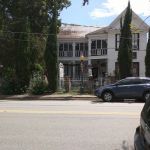 “Welcome to Ghost Tours,” our guide begins in a Scottish accent. I’m in Old Town Spring with my writing buddy, Susie McCauley. It’s a quaint town in Northwest Houston nestled along Spring Creek. And when I say quaint, what I really mean is haunted-to-the-max. Great boutique shopping by day. The Ghost Capital of Texas by night.
“Welcome to Ghost Tours,” our guide begins in a Scottish accent. I’m in Old Town Spring with my writing buddy, Susie McCauley. It’s a quaint town in Northwest Houston nestled along Spring Creek. And when I say quaint, what I really mean is haunted-to-the-max. Great boutique shopping by day. The Ghost Capital of Texas by night.
Susie and I are on the adults-only ghost tour. What does adults-only mean?
The hauntings aren’t sugarcoated. Casper does not live in this town. The stories told aren’t of the Goosebumps variety. No. These are the ghosts of nightmares. Tales that echo through the nighttime streets of Old Town Spring. Unexplainable noises, streetlights that flicker for no apparent reason, and the “someone’s-there” chills that walk up your spine.
And a curse upon the land. One that has troubled the inhabitants since the 1700s. A curse cast by the Akokisa tribe, also known for their cannibalism.
Cannibalism? I hear you ask. Surely not. Houston is the oil and gas industry, land of the conservatives, the—
Yes. Cannibalism.
Long before modern day Old Town Spring existed, it was the winter camp of the Akokisa Indians, known throughout the region as hunters and gatherers and tribe eaters. Since the time of the Akokisas, Old Town Spring has been involved in shoot-outs from the railroad, the Civil War, a high criminal hanging rate, and has experienced countless unexplained fires.
Hello warm-and-welcoming place for spirits to lurk!
History is a bit silent about the Akokisas, so I decided to go to the source. But since the Akokisas have long disappeared, I had to get a bit creative. What better way to get the scoop on these Native American cannibals than to go on a ghost tour?
“If you’ll look across the street—” Our guide points to Hudson’s Whitehall House, a two-story home built in 1895.
 Whitehall House was, in 1933, a funeral home. A funeral home that now has a designated ghost room on the second story. Many sightings have been reported of a man walking across the balcony at night, or a couple swinging together on the porch swing. In the years since, the home has changed hands numerous times.
Whitehall House was, in 1933, a funeral home. A funeral home that now has a designated ghost room on the second story. Many sightings have been reported of a man walking across the balcony at night, or a couple swinging together on the porch swing. In the years since, the home has changed hands numerous times.
One story goes that a new owner decided to renovate the ghost room, disbelieving the spirited history of the house. Just an FYI, ghosts don’t like most decorators. Especially not in their private quarters. The owner experienced “violent spirit activity,” and it took many years for the ghostly couple in the upstairs room to calm down and return to their quiet ways. Now there are two clauses in the rental agreement for Whitehall House: the ghost room is not to be disturbed, and renters are not allowed to break their lease because the house is haunted.
Our guide leads us farther into the town, pointing out the site of a Civil War battle—a spot known to be haunted by a mischievous ghost who throws acorns at unsuspecting visitors (though it may have been a squirrel).
Down the street, our guide stops in front of a large tree.
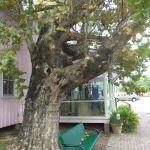 Susie immediately backs away from the tree. “What happened here?”
Susie immediately backs away from the tree. “What happened here?”
I look from her to the tree to our guide, wondering what I’m missing. It’s a tree. A big, beautiful tree.
I should mention here that Susie, who writes fantasy and ghost stories, is a sensitive . . . and this is not her first ghost rodeo.
Our guide stammers, clearly taken aback that Susie can sense something. “That is the hanging tree.”
Goosebumps trace my spine.
We back away.
To the other side of the street.
The tree, while beautiful, served as a form of justice for violators of early Texas law. One of the local judges hung more than sixty criminals on that tree in his time, a very high hanging rate by anyone’s standards.
In fact, he still hangs around. (See what I did there?)
I, clearly, am not a sensitive and would be oblivious to a ghost walking through me. But my writing buddy is pretty freaked by the tree, and our guide mentions it’s her least favorite part of the tour. We move on.
After a few more stories and stops on the tour, one including a bank robbery suspected to be done by Bonnie and Clyde, I still haven’t heard anything about the Akokisas. Not what I expected when we started the evening. Not for a town cursed by a defunct cannibalistic tribe.
Finally, we ask our guide about the trees growing through many of the buildings in town.
“Oh, that,” our guide says in her lilting voice. “That is because of the curse.”
The curse? Could it be? What I’ve been waiting for? The connection of the cannibalistic Akokisas to Old Town Spring?
“The Akokisas cursed this land when the settlers pushed them out.”
Bada-bing, bada-boom. Check, please!
Our guide ignores my big I’m-happy smile and continues. “Any shop owner who has cut down a tree to make improvements or build an addition has experienced fires.”
“Fires?” We exchange worried glances.
“Yes. Multiple. Unexplainable. To the point that some have had to shut down their businesses and move on.”
Whoa. But, really? A three-hundred-year-old curse still causing fires?
At least two buildings have experienced recent fires: the well-known Wunsche Bros. Café & Saloon and an old ice house with a violent spirit past.
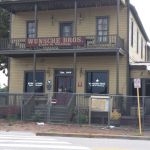 The Wunsche Bros. Café, a staple in Old Town Spring for more than one hundred years, is haunted by the original owner, Uncle Charlie Wunsche. Before the fire, servers reported silverware that had been moved, chairs flipped over, and footsteps on the off-limits second floor. The second floor is Charlie’s domain. Even the curtains remain untouched. But Charlie is one of those friendly prankster ghosts that are more annoying than scary. None of the servers or managers of the Wunsche Bros. Cafe believe Charlie to be the arsonist. Perhaps the curse is in play, due to the new addition to the restaurant?
The Wunsche Bros. Café, a staple in Old Town Spring for more than one hundred years, is haunted by the original owner, Uncle Charlie Wunsche. Before the fire, servers reported silverware that had been moved, chairs flipped over, and footsteps on the off-limits second floor. The second floor is Charlie’s domain. Even the curtains remain untouched. But Charlie is one of those friendly prankster ghosts that are more annoying than scary. None of the servers or managers of the Wunsche Bros. Cafe believe Charlie to be the arsonist. Perhaps the curse is in play, due to the new addition to the restaurant?
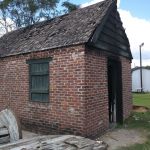 For me, the creepiest stop on the tour was the ice house. It has burned countless times over the years, and when you get close, even the insects go quiet. There’s a heaviness in the air surrounding the small building, and a warning flutters under my skin to stay away. I got close enough for a picture, but, even in daylight, the place is creepy. Turns out, the ice house would occasionally be used as extra storage. In the 1800s, corpses were kept on ice until room could be made for them in the funeral home. No one is sure who or how many spirits reside in the building, but one thing is clear. They do not like visitors.
For me, the creepiest stop on the tour was the ice house. It has burned countless times over the years, and when you get close, even the insects go quiet. There’s a heaviness in the air surrounding the small building, and a warning flutters under my skin to stay away. I got close enough for a picture, but, even in daylight, the place is creepy. Turns out, the ice house would occasionally be used as extra storage. In the 1800s, corpses were kept on ice until room could be made for them in the funeral home. No one is sure who or how many spirits reside in the building, but one thing is clear. They do not like visitors.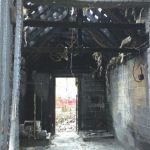
Maybe the three-hundred-year-old Akokisas curse is still affecting this town. There is a fearful respect for the land and the trees here. Fear being the key word. I’d even go so far as to call many of the shop owners “tree huggers,” especially the ones who have built their stores around the trees to avoid the curse.
The tour ends back where we started. The streets are empty. It’s eleven o’clock at night. We are covered in chills, both from the humidity in the air and the tales we’ve heard. Before we head home, we say a prayer to protect us from any spirits who might have decided to hitch a ride.
The next day, when my clothes dryer pops open mid-cycle all by itself, I refuse to believe a spirit has followed me home. I refuse.
And then I hop on Amazon and order some holy water.
Source: Christina Delay took the Houston Ghost Tour. For more information, go to www.houstonghosttour.com.
* All photos taken by the author


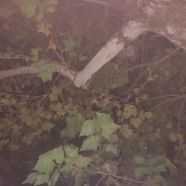





I love ghost tours!!! I had the weirdest experience on a tour in a cemetery in New Orleans.
Wunsche bros upstairs gave me the goosebumps
I had an experience in the ladies room before Wunche burnt down.after asking if it was haunted went to the restroom the lady that was already in there walked out. I went into the first stall in which I clearly heard a woman sigh. I thought wait I didn’t here the door open cause it had a screeching sound. So when I walked out there wasn’t anybody there. When I got back to the table and the waitress brought our drinks. I told her what happened and she said oh so you heard and she said the name i don’t remember. She said yeah she walks around looking for her lover. Sorry I haven’t been back.
That’s crazy! I went there 13 years ago with my young daughter. We were both in stalls. She was in the small stall. I heard footsteps to the sink and the water turned on and off. I told my daughter to wait for me and she said mom, I’m still on the potty. I looked down and sure enough her feet were dangling. Door never opened!
The Aura that hangs over the entire city of Spring, concentrating heavily around the creek ( the Akokisas’ main water supply ) is very dark and strong and affects the overall mood of this city to this day …
It’d be cool if you were able to go deeper with your research, I believe many would be interested to read
I went there 20 years ago when on holiday in Houston from Scotland.
My boyfriend at the time and I visited the town in bright sunlight early afternoon on a week day.
I felt very creeped out for no reason I could think of.
I had never heard of it before and went because it’s a tourist attraction and very pretty with strange shops and lots of white picket fences.
My hair was standing on end as hardly anyone about. Those people I did see also gave me the creeps.
Consider the good weather and time of day one would have thought it would be very busy.
Even when we went for a soft drink the waitress gave me the creeps.
I couldn’t put my finger on it but many quaint little shops seemed to be deserted. It was like entering another reality.
We left as quickly as possible.
I am a sensitive but had never heard anything about it being haunted but I shared my experience with family when I got home to Scotland.
🏴
In my opinion it is full of ghosts 🫣👻👻👻👻👻
You two are much braver than I am! It sounds like a great place to get your spook on.
What an amazing sounding tour! Just the kind I like!
What a great write up on a wonderful little town. I love all the history you have put into it and I love your friend who could feel something wasn’t right when you were by the tree.
Great write up Christina, do some more as we love them!
My daughter took this tour at 14 years of age as we live just about 10 minutes away from Old Town Spring. My father worked in the grocery store as a delivery boy and had many strange experiences while bringing the groceries in for many residents in the mid 1950’s. My daughter felt the cold touch of someone…or spirit, she thought it was her friend playing a joke until she realized the touch was freezing cold and her friend was across the crowd and nobody was behind her by the ice house😱. Her and her friend both captured orbs and a whispy, cloud like being in photos. I must go soon to take this tour, I have lived in the Houston area for my entire life and have never taken the Old Town Spring ghost tour yet, even though the last 20+ years I’ve only been shopping in the quaint little country shops many, many times and we try to attend the annual Crawfish festival every year, except the past two due to Covid. If you are ever down this way, you must shop Old Town Spring during the day and perhaps take the tour at night, if you’re brave enough!😉👻 Boo Y’all!🥶
Thank you everyone! I’m so glad you enjoyed the article. The tour was a ton of fun. I’ve done a few ghost tours – one of the funnest ways to learn the history of a place!
I just want on this tour last weekend. And in the ice house I stayed for about 15 20 mins. I had my camera on with my flash off in all settings the only way for my flash to go off is if I touched my screen to focus. Well as I settled in to wait holding my camera up hoping to catch something my flash starts going off like a strobe light. Still not touching anything not only did my flash continue to go off then my camera on my phone starts taking pictures without my clicking on anything.
This tour is amazing and we experienced so many other interactions some good some very very evil. I strongly recomend this your if you like this sort of thing.
Andre
Awesome story of your visit!!! I’m only 10 minutes away from Old Town, I’ve shopped the stores many times and visited as a child with my dad, who by the worked in the grocery store in the mid 50’s as a grocery delivery boy entering many of these homes back then and always had stories to tell of his peculiar encounters of the paranormal! Great stuff! Boo y’all😱👻🥶
I used to live by old Town spring because I lived in spring
I use to work at the McDonalds in Spring T.x. Mr Ramon Hudson has a house in Old Time Springs. I will never forget him he was so kind and a great listener he gave me a painting in 96 I still have it and will treasure it! He use to give my children tours through his home I will never forget How kind he was and the great advice!! I was sad when they came to let us know he passed away he will never be forgotten ❤️
Watched this on the Travel Chanel…..
Very interesting and frightening….
Will watch and read about again!
I thought the hanging tree was the one behind the judges house? And the tree pictured here is the one that the “ladies” stood by.
I dont believe it. First of all.. speak to the supposed ghost. Ask where it is. What surrounds it. Is there life after death? Prove it. Nobody ever does that. Talk.
Sure they do, but you need to be open minded and a sensitive to experience an answer!😉😱
I’ve been in the ice house and it wasn’t creepy. I’ve seen the ghost that lives in the museum though. I had no idea there was a ghost in there until I saw her and she vanished around a corner when I went to talk to her. You can get some creepy feelings all over OTS even during the day if you’re paying attention.
Watched the show about this town on The Travel channel. There were women who lived there and a male who has been taunted by the spirits of the children who died in the early 1900’s. They went to the cemetary and there were unmarked graves. Thanks for talking about the tour, I’m guessing anyone who is a sensitive will pick up energies from those who perished. I would take equipment if I went there to see what responses would come through, thanks.
Interesting…
lived here over 50 years, my family has been here since the late 1800’s and this is the first I’ve head of any ‘land curse’.
I’ve vague recollection of talk about the Cafe and Whitehall hauntings, but that’s about it.
A large number off the various ‘shops’ are in buildings that were moved into Spring (Ex: Puffabellys) or built after the towns….resurrection.
True,I have never heard anything about ghosts in Old Town Spring.I am suspicious because we investigate in our Part time. I have seen a lot and I know about Potbellys but why is it all the sudden haunted?
Wow, One day I hope I save enough money to travel to Texas just so I can go to Old Town Spring. I love ghosts of any kind. That’s so spooky. Hopefully in the near future. 👻👻👻👻👻
I grew up in Spring, and the town always seemed strange. We would eat at The Old Town Spring Cafe, then shop at Mallott’s (spelling?) for our shoes. I worked in the old Hi-Lo auto parts store, before it became O’Reillys. I can say that that old store, was creepy as #%€@! I lived in a neighborhood that frequently flooded, due to rising waters of Spring Creek. Many people have passed on due that that alone. It doesn’t surprise me to hear of ghosts in Spring, Texas. My old hometown!!
Went on the tour and actually caught a arm or hand out coming
of Charlie’s room window. My daughter’s wedding dress was
bought a Whitehall. Had no idea it was haunted. Also ate
at Wunsche’s. Great food and even went upstairs. Really cool
upstairs.
I’m sure the so called hanging tree may be old but I doubt very much it’s that old. I recently read an article about a tree Texas A&M had analysed and it was the oldest tree in Texas (the tree was from a city north of Dallas called Plano).
I grew up in Spring and frequently visit old time spring after school, I never knew of the ghost stories. I used to walk around the hanging tree and the icehouse at night and honestly never felt anything sinister. I also performed a few of my native ceremonies there, maybe I was being protected by the Akokisha tribe spirits. I also tried to dig and couldn’t find any legit source that says that the Akokisha tribe people were cannibals, another fabricated lie to make native people look evil.